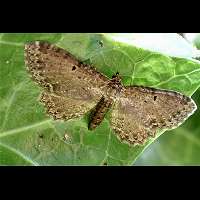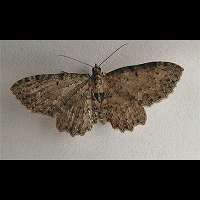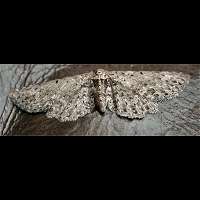Dentated Pug (Anticollix aparsata)
The Dentated Pug is bigger than most other pugs (and is not a pug really). But it certainly does look like one. The edge of the hindwing is dentated and this makes it extremely easy to identify this species, even when it's worn out. The wingspan usually is some 20 to 25 mm.
The caterpillar is bright green. A conspicuous white line runs over the sides. There are a varying number of other very small yellowish or whitish lines running over back and sides. The segments are yellow on either end. The head is dull green and the caterpillars of the Dentated Pug will reach a length of 22 mm at most. The eggs hatch from the end of July. The larvae feed at night and rest at day, often on shoots of the plants or fully strectched on the center vein of a leaf. They are very hard to discover. To overwinter the larvae spin a cocoon in the foodplant and in it they pupate. The only foodplant known is Yellow Foodstrife, of which leaves and flowers are eaten. This species doesn't like warmth and drought. The foodplants choosen are usually in the shade and it prefers swamps, marshes, river banks etc. The pupae are difficult to breed in captivity as they soon dry out.
In Britain the Dentated Pug is single brooded and on the wing in June and July. Starts flying in early dusk. Comes to light in small numbers and is rarely seen otherwise. Prefers wet or damp places. In Britain a scarce species, only to be found in parts of England and Wales. Not seen in Scotland and Ireland, even though the foodplant is abundantly present. On the continent less scarce, but not common anywhere. Is double-brooded on most of the continent.
The Dentated Pug is bigger than most other pugs (and is not a pug really). But it certainly does look like one. The edge of the hindwing is dentated and this makes it extremely easy to identify this species, even when it's worn out. The wingspan usually is some 20 to 25 mm.
The caterpillar is bright green. A conspicuous white line runs over the sides. There are a varying number of other very small yellowish or whitish lines running over back and sides. The segments are yellow on either end. The head is dull green and the caterpillars of the Dentated Pug will reach a length of 22 mm at most. The eggs hatch from the end of July. The larvae feed at night and rest at day, often on shoots of the plants or fully strectched on the center vein of a leaf. They are very hard to discover. To overwinter the larvae spin a cocoon in the foodplant and in it they pupate. The only foodplant known is Yellow Foodstrife, of which leaves and flowers are eaten. This species doesn't like warmth and drought. The foodplants choosen are usually in the shade and it prefers swamps, marshes, river banks etc. The pupae are difficult to breed in captivity as they soon dry out.
In Britain the Dentated Pug is single brooded and on the wing in June and July. Starts flying in early dusk. Comes to light in small numbers and is rarely seen otherwise. Prefers wet or damp places. In Britain a scarce species, only to be found in parts of England and Wales. Not seen in Scotland and Ireland, even though the foodplant is abundantly present. On the continent less scarce, but not common anywhere. Is double-brooded on most of the continent.






